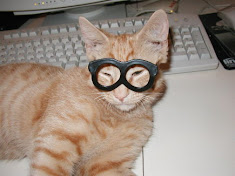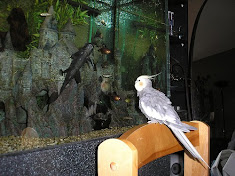Of course, cats meow. And the type of meow they use gives you a good idea of what they're trying to communicate with you. This is especially true if your pet is a Siamese cat. This type of cat is very vocal. One Siamese owner had a cat that meowed loudly - and persistently - whenever it wanted to play a game of hide and seek. Every time the cat used his "special meow", which the owner recognized, she knew that he was "hiding" and needed to be "found". She dutifully played.
 |
| Your Talking Cat by Rusty Sheriff |
In fact, Siamese cats have a voice that's often mistaken for a human voice. When a Siamese cat is in heat, she sounds very human-like. Don't be surprised if your cat almost seems to be saying "hello". It's eerie to hear in the middle of the night. Many individuals also think that the meow of a Siamese cat is similar to a human baby crying.
But all cats use their voices at one time or another. And there are a variety of ways in which the voice of a cat indicates what the feline is trying to convey through "cat chat". The differences in pitch, intensity, frequency and even the pace and cadence of the cat's voice all leave clues about his feelings. The quicker the meows, for example, the more anxious or even frightened your pet may be. The slower the sounds, the more confident and relaxed he is. In addition to the occasional meow, cats more than likely will talk to you through a variety of other behaviors.
A favorite method of communicating is the cat's purr, which is unique to the feline species. You may already know that a cat purrs when he's content. Animal behaviorists now believe that they also purr when they are in the mood to be sociable.
However, if you pay close attention to your cat, you'll notice that he also purrs when he's nervous, feeling a little uneasy or even if he's in great pain. Some experts think it's a feline form of "meditation" and that this action comforts them. If this theory is at all correct, the "purring" sound of the feline is the equivalent of our "Ohm" when we meditate.
 |
| Photo Credit: Jstar1223 |
You probably are already aware that a "puffed up" tail indicates fear. You'll recognize this signal as soon as you see it. Your pet's tail will be at least twice the size it normally is. Could mean that he's been fighting with another cat, or he's just encountered something unexpected that startled him. A cat who is feeling "good about himself" will hold his tail high. A tail held a little lower indicates that he is feeling relaxed and relatively content. Cats possess something called a "third eyelid". This is a layer of skin that you can sometimes see that surrounds the cat's eyes. If you can see this, then you cat is either ill or extremely content and sleepy. The eyelid shows especially if your cat is running a fever.
You'll be able to tell if your feline friend is ill by other behavior. She won't be acting her normal self. If this lasts for more than several days, take your pet to the veterinarian if at all possible. Cats are very good at trying to disguise their true feelings. They may try to hide the fact that they are ill. Why? Because when their ancestors were out in the wild, many thousands of years ago, an ill cat did not live very long. So, cats try to keep a "stiff upper lip", as it were, in order to be able to survive as long as possible.
Your cat's third eyelid may be showing on the other hand because he's very content and near the point of sleeping. Again, by paying some attention to his other body language, you'll be able to read the signals.
Does your cat "head-butt" you? That's the cat's standard affectionate greeting. Try "head-butting" him back. Seriously. Not very hard of course. You'll discover that he really enjoys this. You'll also soon discover that you've got a bond forming with this feline.
Another form of an affectionate greeting is "the lick". Hard to believe, isn't it? But from the very moment he was born, his mother licked him. In his mind it's associated with love. In fact, this is the only way his mother had to clean him. When your cat takes that sandpaper-rough tongue and licks your skin, fight the first impulse to jerk your body part away. You really don't want to hurt his feelings, now do you?
Make no mistake about it. Cats are smart creatures. Some animal behaviorists even theorize that some cats possess the intelligence of a two-year-old human. So just be patient - and pay attention. Soon you and your cat will have your own subtle form of communication. And it'll be most enjoyable and satisfying.
About the Author
Written by Jim Moore
Jim Moore appreciates that you should take care and give loving attention to your cat. Jim owns and maintains http://www.apurrfectcat.com
Article Source: http://www.articlesbase.com/pets-articles/how-cats-communicate-357327.html



0 comments:
Post a Comment